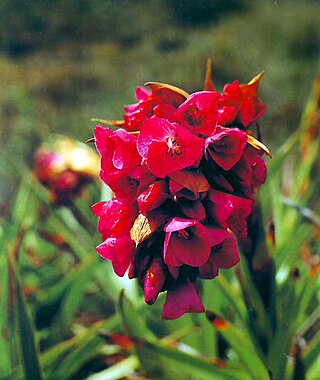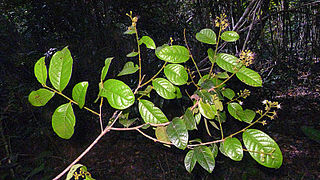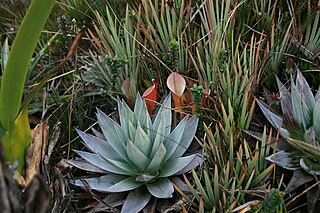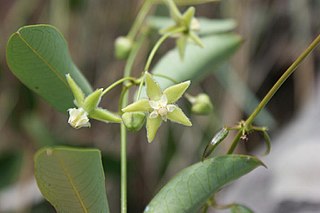
Abolboda is a genus of flowering plants, traditionally and nowadays assigned to family Xyridaceae. It is native to tropical South America and to the island of Trinidad, generally on marshy savanna.
Brewcaria is a genus of plants in the family Bromeliaceae. The genus is named for Charles Brewer-Carías, Venezuelan explorer and naturalist. Some authorities treat Brewcaria as a synonym of Navia. It contains 6 known species, all native to Colombia and Venezuela.

Connellia is a genus of plants in the family Bromeliaceae. The genus name is for Frederick Vavasour McConnell, English ornithologist and biologist (1868-1914). There are 6 known species, all native to the Guyana Highlands of Guyana and Venezuela.

Pitcairnia is a genus of plants in the family Bromeliaceae, subfamily Pitcairnioideae. It was named for William Pitcairn, Scottish physician and gardener (1711–1791). The genus Pitcairnia ranks as the second most prolific of the bromeliad family. They are most abundant in Colombia, Peru and Brazil, but can also be found in areas from Cuba and Mexico south to Argentina. One species, Pitcairnia feliciana, is found in tropical West Africa and is the only member of the family Bromeliaceae not native to the Americas.

Navia is a genus of plants in the family Bromeliaceae, containing 95 species. Described as early as 1830 in Guyana, they are commonly cultivated for their colorful foliage and inflorescences. All the species are native to northern South America.
Steyerbromelia is a genus of plants in the family Bromeliaceae, subfamily Navioideae. All the known species in the genus are native to southern Venezuela, northern Brazil and Colombia.

Hirtella is a genus of 110 species of woody trees in family Chrysobalanaceae. It was first described as a genus by Linnaeus in 1753. Hirtella naturally occurs in tropical forests throughout Latin America, the West Indies, southeast Africa, and Madagascar. The flowers are mainly pollinated by butterflies.

Couepia is a genus of flowering plants in the family Chrysobalanaceae described as a genus in 1775.
Achnopogon is a genus of flowering plants in the family Asteraceae, described as a genus in 1957.
Lindmania guianensis is a plant species in the genus Lindmania. This species is native to Venezuela and Guyana.

Cerro de la Neblina, also known as Serra da Neblina in Brazil and Sierra de la Neblina in Venezuela, is a sandstone massif located in the northern Amazon Basin. It is a tilted, heavily eroded plateau, with a deep canyon in its central portion, drained by the Baria River.

The natural range of the carnivorous plant genus Heliamphora is restricted to the southern Venezuelan states of Amazonas and Bolívar, and to adjacent portions of northern Brazil and western Guyana, an area corresponding to the western part of the Guayana Shield. These plants are largely confined to the summits and foothills of the sandstone table-top mountains of the region, known as tepuis.

Achlyphila is a genus of plants in the Xyridaceae, first described as a genus in 1960. It contains only one known species, Achlyphila disticha, endemic to the Serranía de la Neblina National Park in the State of Amazonas in southern Venezuela, very close to the border with Brazil.

Blepharodon is a genus of plant in the family Apocynaceae, first described as a genus in 1844. They are native primarily to South America, with one species extending into Central America and Mexico.

Rapatea is a group of plants in the family Rapateaceae described as a genus in 1775.

Stegolepis is a group of plants in the family Rapateaceae described as a genus in 1872.
Bassett Maguire was an American botanist, head curator of the New York Botanical Garden, and a leader of scientific expeditions to the Guyana Highlands in Brazil and Venezuela.
Chromolaena squalida is a South American species of flowering shrub in the family Asteraceae. It is found in Brazil, Paraguay, Bolivia, Peru, Colombia, Venezuela, Guyana, Suriname.

The Serranía de la Neblina National Park is a national park of Venezuela.
Maguireocharis is a monotypic genus of flowering plants belonging to the family Rubiaceae. It only contains one known species, Maguireocharis neblinaeSteyerm.













